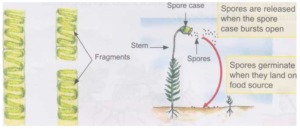How Plants can Reproduce Asexually
Reproduction in plants
The process of producing young ones from their parents is known as reproduction. Plants reproduce through asexual, vegetative, and sexual means.
Asexual reproduction involves either the simple division of the plant body into two or more parts or the formation of spores. A new plant body is formed from a single parent. This happens under favourable conditions.
Vegetative reproduction is also a type of asexual reproduction in which a cell, tissue, or part of an organ of a plant develops into a new organism.
Sexual reproduction takes place by the formation of seeds. It involves two parents and the fusion of male and female reproductive cells called gametes to form a single cell called the zygote.
Asexual reproduction
The formation of new plants from the cells of a single parent is called asexual reproduction. Asexual reproduction is the simplest form of reproduction found in plants. It is of three common forms: budding, fragmentation, and spore formation.
Budding
Budding Microscopic organisms, such as yeasts, reproduce asexually by budding. In this process, a small bulb-like cellular outgrowth, called bud, is formed from the cell. This bud keeps on increasing in size and forms an independent organism which separates from the parent.

Activity
Aim: To observe budding in yeast
Materials needed: A petridish, sugar, baker’s yeast (dry), warm water, and a magnifying glass
Method:
1. Put some dry yeast in warm water and some sugar in a petridish.
2. View it using a hand lens.
Observation: When dissolved in warm water and sugar, the yeast cells get activated and bubbles are given out. A certain characteristic smell is also given out.
Conclusion: The yeast cells divide to multiply and increase the volume of the solution.
Fragmentation It is a very common form of asexual reproduction found in algae. Some algae, such as Spirogyra (pond silk), Fucus, etc., are the slimy, green, and small plants seen floating on the surface of ponds or in dirty drains. In this process, the adult organism just breaks up into two or more pieces called fragments. Each of these fragments grows up to become a new plant.
Spore Formation Some plants such as ferns arid mosses multiply asexually through spores. Spores are microscopic single-celled or several-celled reproductive bodies that are mostly spherical in shape. They are protected by a thick wall when conditions (such as humidity and temperature) are unfavourable. Once the conditions for germination are favourable, these spores burst out of the thick wall, start multiplying, and grow into new plants.
Ferns and mosses are also known as lower plants. They do not have roots, do not flower, and do not have seeds. So, they multiply with the help of spores.

Ferns and mosses are also known as lower plants. They do not have roots, do not flower, and do not have seeds. So, they multiply with the help of spores.
